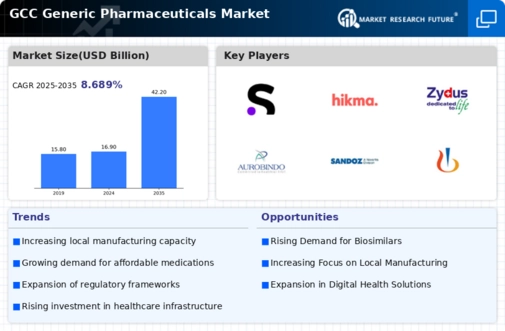Growing Healthcare Expenditure
The increasing healthcare expenditure in the GCC region is a pivotal driver for the generic pharmaceuticals market. Governments are allocating larger budgets to healthcare, aiming to improve access to medications. In 2025, healthcare spending in the GCC is projected to reach approximately $200 billion, reflecting a growth rate of around 5% annually. This surge in spending is likely to enhance the availability of generic drugs, as healthcare providers seek cost-effective alternatives to branded medications. The emphasis on affordable healthcare solutions aligns with the rising prevalence of chronic diseases, necessitating a broader range of accessible treatment options. Consequently, the generic pharmaceuticals market stands to benefit from this trend, as patients and healthcare systems increasingly turn to generics to manage costs while ensuring effective treatment.
Shift Towards Preventive Healthcare
The GCC region is witnessing a notable shift towards preventive healthcare, which is influencing the generic pharmaceuticals market. As populations become more health-conscious, there is a growing demand for medications that prevent diseases rather than merely treating them. This trend is supported by government initiatives promoting wellness and preventive measures, which are expected to drive the consumption of generic drugs. In 2025, it is estimated that preventive healthcare spending will account for about 30% of total healthcare expenditure in the region. This shift not only encourages the development of generic preventive medications but also enhances the overall market landscape, as healthcare providers increasingly incorporate generics into their treatment protocols.
Rising Incidence of Chronic Diseases
The rising incidence of chronic diseases in the GCC is a significant driver for the generic pharmaceuticals market. Conditions such as diabetes, hypertension, and cardiovascular diseases are becoming increasingly prevalent, leading to a higher demand for effective treatment options. In 2025, it is projected that over 25% of the adult population in the GCC will be diagnosed with diabetes, necessitating a robust supply of affordable medications. Generic pharmaceuticals offer a viable solution, providing cost-effective alternatives to branded drugs. This trend is likely to stimulate market growth, as healthcare systems prioritize the availability of generics to manage the escalating healthcare burden associated with chronic diseases.
Increased Focus on Regulatory Compliance
Increased focus on regulatory compliance is emerging as a vital driver for the generic pharmaceuticals market. Regulatory bodies in the GCC are implementing stricter guidelines to ensure the safety and efficacy of medications. This heightened scrutiny is compelling manufacturers to enhance their compliance measures, which, in turn, fosters consumer confidence in generic products. As of 2025, it is anticipated that compliance with these regulations will lead to a 20% increase in the approval rates for generic drugs. Consequently, the generic pharmaceuticals market is likely to benefit from a more robust regulatory environment, encouraging the development and distribution of high-quality generics.
Technological Advancements in Drug Development
Technological advancements in drug development are playing a crucial role in shaping the generic pharmaceuticals market. Innovations in manufacturing processes, such as continuous manufacturing and advanced formulation techniques, are enhancing the efficiency and quality of generic drug production. These advancements are expected to reduce production costs and time, making generics more accessible to patients. In 2025, the adoption of such technologies could potentially increase the market share of generics by up to 15%. As a result, the generic pharmaceuticals market is likely to experience accelerated growth, driven by improved production capabilities and the ability to meet the rising demand for affordable medications.

















Leave a Comment